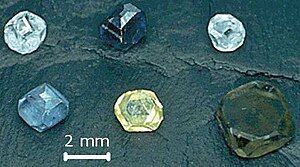Synthetic diamonds of various colors grown by the high-pressure high-temperature technique
Synthetic diamond is diamond produced in a technology process, as opposed to natural diamond which is created in geological processes. Synthetic diamond is also widely known as HPHT diamond or CVD diamond where HPHT and CVD refer to the production method, namely high-pressure high-temperature synthesis and checmical vapor deposition, respectively.
 Numerous claims of diamond synthesis were documented between 1879 and 1928; every attempt has been carefully analyzed and none has been confirmed. In the 1940s, systematic research began in the United States, Sweden and the Soviet Union to grow diamond using CVD and HPHT processes. The first reproducible synthesis was reported around 1953. Those two processes still dominate the production of synthetic diamond. A third method, known as detonation synthesis, has entered the diamond market in the late 1990s. In this process, nanometer-sized diamond grains are created in a detonation of carbon-containing explosives. A fourth method, treating graphite with high-power altrasonic radiation, has been demonstrated in the laboratory, but as yet there is no commercial application.
Numerous claims of diamond synthesis were documented between 1879 and 1928; every attempt has been carefully analyzed and none has been confirmed. In the 1940s, systematic research began in the United States, Sweden and the Soviet Union to grow diamond using CVD and HPHT processes. The first reproducible synthesis was reported around 1953. Those two processes still dominate the production of synthetic diamond. A third method, known as detonation synthesis, has entered the diamond market in the late 1990s. In this process, nanometer-sized diamond grains are created in a detonation of carbon-containing explosives. A fourth method, treating graphite with high-power altrasonic radiation, has been demonstrated in the laboratory, but as yet there is no commercial application.

No comments:
Post a Comment